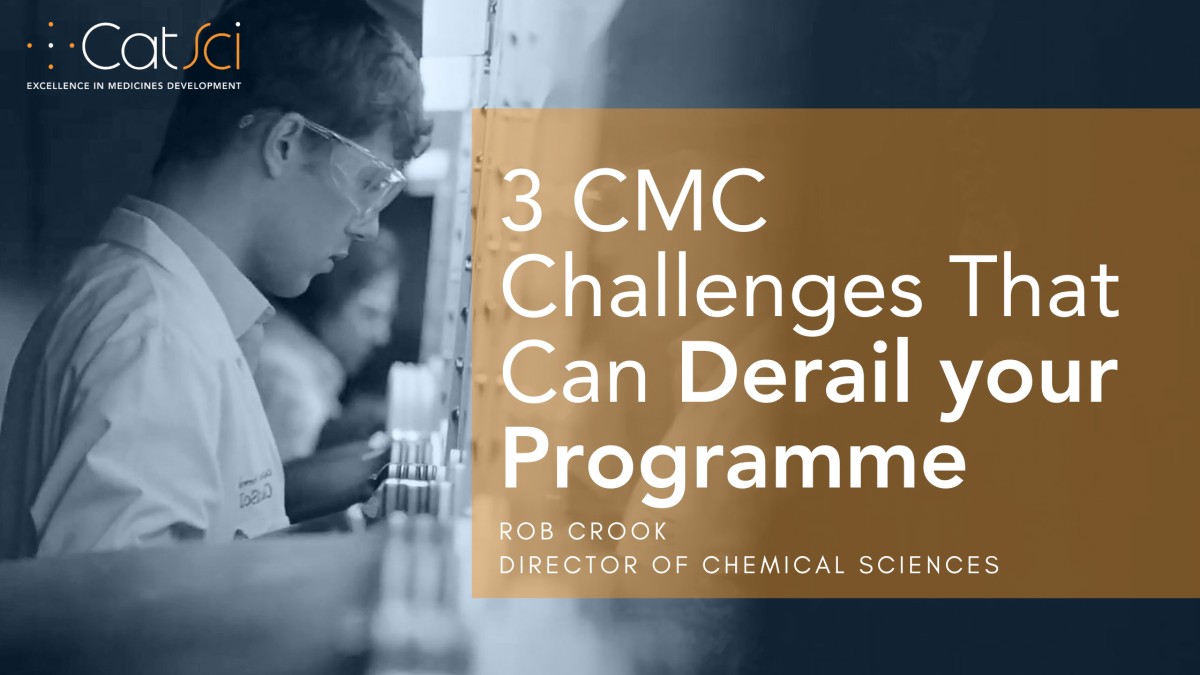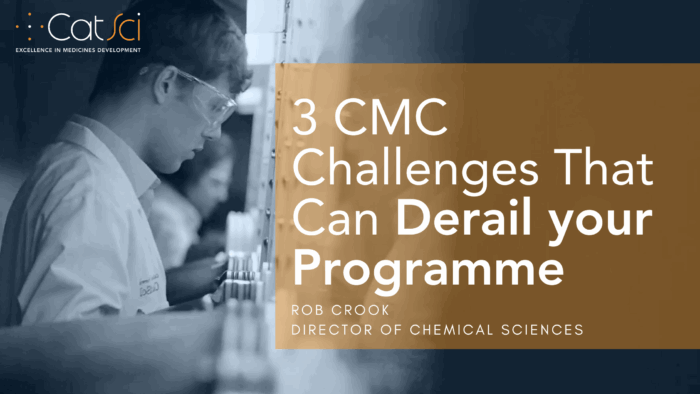
- 18 Feb 2025
- Rob Crook
3 CMC Challenges That Can Derail Your Programme

3 CMC Challenges That Can Derail Your Programme – Rob Crook, Director of Chemical Sciences
Introduction
The biotech sector continues to evolve and grow, driven by rapid advancements in next-generation therapeutics. Yet, for emerging biotechs with lean teams and venture-backed budgets, the journey from a promising discovery to a viable clinical candidate comes with a plethora of CMC challenges.
Biotechs play a vital role in medicines development. They are driving forward innovation, tasked with transforming fundamental scientific theories into promising molecular candidates, and then on to scalable, compliant processes ready to make material for clinical studies. However, as research teams achieve success in translating this fundamental science into the discovery of potential drug candidates, integrating development expertise, and understanding how to move the molecules into the clinic becomes paramount. Failure to plan, and engage with the right expertise for the journey beyond discovery will likely determine whether an asset successfully advances with speed to the next milestones, or falters due to rising costs and delays.
“I consider one of my core responsibilities at CatSci as guiding our partners towards the best decisions for their molecule. We utilise our expertise to work with them to develop an excellent and thorough plan that clearly determines the steps required to achieve their goals.”
In this article, I will shed light on three critical challenges that biotechs will encounter during scale-up. By drawing attention to the underestimated and poorly understood complexities of CMC, the risks inherent in scale-up, and the dangers of prioritising speed over strategy, I will explore some of the practical and scientific challenges that can make or break a development programme. Drawing on my 30+ years of experience, I will provide actionable insights to help you navigate these challenges, ensuring the success of your programme whilst delighting investors.
Whether your goal is to hit key milestones swiftly, mitigate risk, or secure additional funding, a well-crafted CMC strategy is critical to your future success.
1. Underestimating CMC Complexities
In the excitement and laser focus of early discovery, the enthusiasm around novel targets or unprecedented mechanisms can push the critical question into the shadows: “How will we manufacture this molecule at scale?”
Early-stage focus rightly prioritises demonstrating efficacy in preclinical models, leaving longer-term scalability and techno-commercial viability for later consideration. This oversight can cause severe challenges once the project advances beyond the discovery lab and into the realm of scale-up, GMP and regulatory dossiers. Without considering the complexity of the next steps in the molecule’s journey sufficiently early, missteps become inevitable, leading to likely delays and potentially increased costs.
The Challenge?
Everyone wants to see exciting new molecules move through the development pipeline with velocity, whether it is the scientists, management, investors or patients. However, when CMC complexities are not embraced early enough, difficulties can occur:
- An undevelopable, or exquisitely challenging molecule can be nominated as the preferred candidate, with challenges linked to scalability of chemistry, solid form, formulatability.
- Not engaging the right partners, with appropriate skills and knowledge early enough. This will likely lead to increased timelines, increased costs, and increased risk of challenges along the development path.
Both of the above can lead to challenges for organisations. In the worst case, it can even mean returning to the discovery lab to identify a more scalable candidate, or in some cases repetition of manufacturing campaigns, and inevitably an increase in timelines and costs of execution, something no one, whether it’s scientists, investors or patients, wants to see.
How to Overcome CMC Complexities?
Adopting a holistic CMC perspective from the start will dramatically reduce downstream risks and avoid later-stage surprises. Close collaboration between discovery scientists, process chemists, and analytical teams ensures that synthetic pathways, material selection, and analytical methods are well understood. Early feasibility studies help identify potential roadblocks, guiding informed decisions about optimal synthetic routes and formulations. Developing a phase-appropriate execution plan and regulatory strategy offers a roadmap that will successfully advance your molecule and will also be able to adapt as new data emerges.
For drug development the 6P rule definitely applies: Prior Proper Planning Prevents Poor Performance.
2. Prioritising Speed Over Strategy
The hyper-competitive and rapidly evolving biotech landscape means the intense urgency to push promising drug candidates into clinical trials is undeniable. We all understand the importance of being in the first two or three compounds onto the market in a particular therapeutic area. While speed is understandably paramount – especially for therapeutics addressing unmet medical needs – pace should not be at the expense of appropriate scientific rigour. A hurried approach that prioritises pure speed at the expense of an appropriate level of robust process understanding threatens campaign failures, regulatory setbacks, or even potential safety risks. Achieving the right balance is not simply about slamming on the brakes; it’s about allocating resources wisely to maintain quality, safety, and reliability while meeting critical timelines, ensuring that short-term gains do not undermine long-term goals for both patients and investors.
“If you were planning a long road trip, you would not simply set off at 100 miles an hour without a clear roadmap. The same principle applies when advancing a compound through into the clinic. With the right expertise and well-crafted strategy, you’ll reach the quickest, most efficient path to your destination.”
The Challenge?
An agile CMC strategy emphasises structured decision-making, reflecting a thorough approach where risk assessment and contingency planning guide each decision. Without a sufficiently thought-through plan, and a simple risk-based approach, issues are likely to be encountered which can lead to costly delays and project hurdles.
How to Overcome the Speed vs Strategy Battle?
A forward-thinking CMC approach builds lasting value by creating an adaptable, resilient plan that can adapt quickly to unforeseen challenges or changes in strategy. By prioritising critical activities, teams can accelerate areas that truly matter without compromising overarching quality standards. Incorporating modular development strategies can also expedite progress. This approach allows for a quicker pivot if an unexpected challenge arises, thereby maintaining momentum while preserving the scientific integrity essential for regulatory approvals.
Plus, investors value programmes that demonstrate not only clinical promise, but also offer operational and manufacturing resilience, as such characteristics enhance the likelihood of a successful exit or acquisition. Ultimately, a well-executed CMC plan forms the backbone of sustainable innovation.
3. Ignoring Scale-Up Risks
The path from lab to kilo lab or pilot scale is rarely smooth. Translating a laboratory-scale synthesis to a pilot scale facility introduces a myriad of challenges. Seemingly simple equipment changes, like shifting from a round-bottom flask to an industrial reactor, will alter reaction kinetics, may cause mixing issues, and can introduce unanticipated side reactions. Additionally, process safety considerations and handling hazardous reagents becomes more important and challenging at scale. Without proper process characterisation and advanced planning, these challenges can derail timelines and inflate costs, jeopardising clinical development objectives.
The Challenge?
Efficiently scaling up a process requires deep knowledge of the generic challenges that can be faced, but also knowing that every molecule brings its own scale-up challenges. Safe development of processes requires investment of resources and time. Up-front investment into this work will help reduce issues and challenges on scale-up. This work helps avoid unexpected complications, such as low yields, impurities, or stability issues. In preclinical or early-stage clinical programmes, these delays clearly impact the path to the clinic and key milestones required to secure further development funding.
In the worst cases, the history of the industry is littered with examples where a complete restart of the development process is required.
How to Overcome Scale-Up Risks?
Robust process development begins with a thorough mechanistic understanding, which guides the selection of equipment, solvents, and reaction conditions that will scale efficiently. Employing extensive and, where appropriate, tools such as design of experiments (DoE) and process analytical technology (PAT) can highlight process risks early, significantly reducing the likelihood of surprises.
Collaborating with the best CROs and CDMOs, experienced in moving molecules from the preclinical space rapidly into development, is crucial. Working with these organisations will give you the best chance of successfully moving your molecule rapidly along the development path taking a low-risk phase-appropriate approach. The most critical element to explore is the level of knowledge and understanding of your partner on how to develop molecules and move them rapidly into the clinic, dovetailing their scale-up knowledge and understanding with your needs as an organisation and helping support you in getting to your key milestones quickly and efficiently. Most organisations will have appropriate quality systems and equipment, but a key differentiator should be their level of experience and ability in laying out a flexible CMC plan which helps you achieve all your desired goals.
Conclusion
The successful journey from discovery to clinical validation hinges on a well-executed CMC strategy. Underestimating CMC complexity can lead to fragmented processes, while inadequate scale-up planning may increase both timelines and costs. Lastly, balancing speed with strategy will lay the very foundations of product quality and patient safety. Addressing these challenges demands a balance of scientific rigour, managerial foresight, and cross-functional collaboration. For emerging biotechs, the reward for navigating these challenges effectively includes a smoother path to IND or BLA filings, as well as saved money, time, and resources, but also the confidence of investors and regulatory authorities alike.
By championing a robust CMC framework, you can secure not only your programme’s viability but also the future of transformative therapies.
Further Support
For those seeking further depth, scientific journals such as the Journal of Pharmaceutical Sciences, Organic Process Research and Development, and online resources from organisations like the International Council for Harmonisation (ICH) offer technical guidance on topics ranging from analytical method validation to process scale-up. Furthermore, enlisting the support of specialised partners can expedite knowledge transfer and reduce the learning curve. By expanding your resource network, you not only fortify your scientific approach but also enhance the likelihood of a successful journey toward clinical and commercial milestones.
If this sounds like something you require, I’d be happy to chat through your projects with you. You can reach out here, or connect with me on LinkedIn.